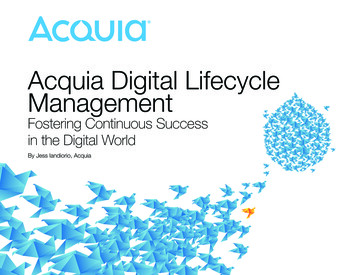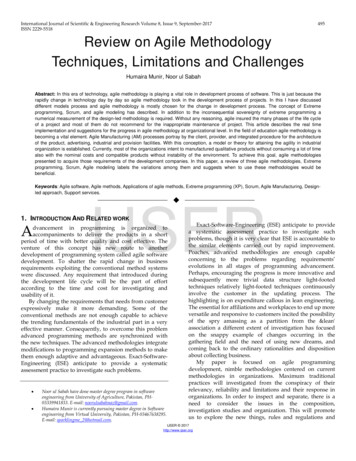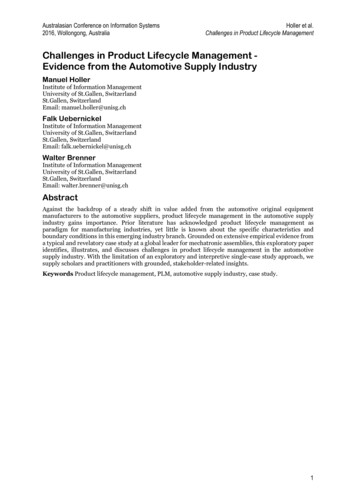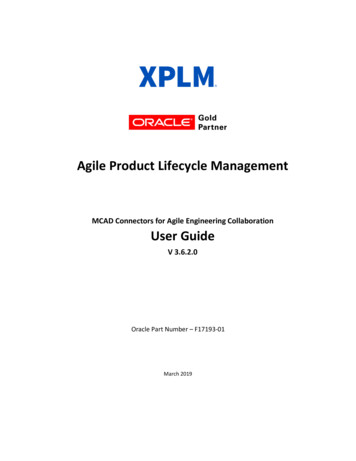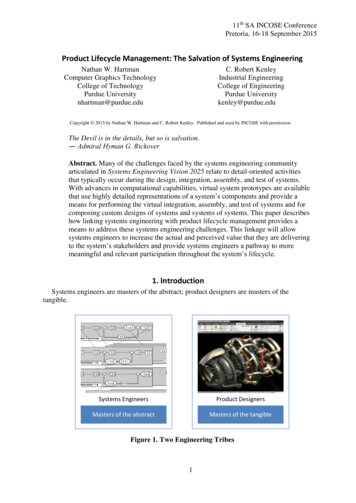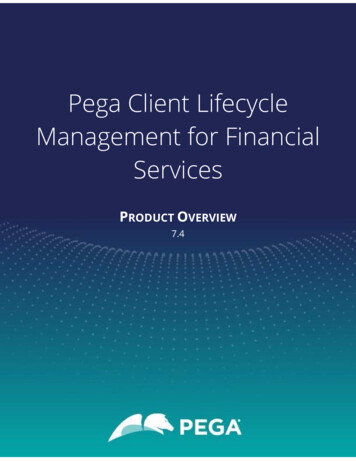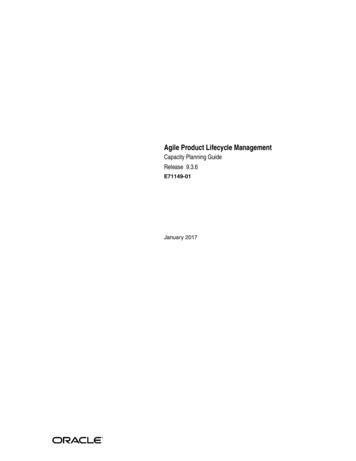
Transcription
[1]AgileProduct Lifecycle ManagementCapacity Planning GuideRelease 9.3.6E71149-01January 2017
Agile Product Lifecycle Management Capacity Planning Guide, Release 9.3.6E71149-01Copyright 2010, 2017, Oracle and/or its affiliates. All rights reserved.Primary Author: Oracle CorporationContributing Author: Edlyn SammanasuContributor:This software and related documentation are provided under a license agreement containing restrictions onuse and disclosure and are protected by intellectual property laws. Except as expressly permitted in yourlicense agreement or allowed by law, you may not use, copy, reproduce, translate, broadcast, modify, license,transmit, distribute, exhibit, perform, publish, or display any part, in any form, or by any means. Reverseengineering, disassembly, or decompilation of this software, unless required by law for interoperability, isprohibited.The information contained herein is subject to change without notice and is not warranted to be error-free. Ifyou find any errors, please report them to us in writing.If this is software or related documentation that is delivered to the U.S. Government or anyone licensing iton behalf of the U.S. Government, then the following notice is applicable:U.S. GOVERNMENT END USERS: Oracle programs, including any operating system, integrated software,any programs installed on the hardware, and/or documentation, delivered to U.S. Government end usersare "commercial computer software" pursuant to the applicable Federal Acquisition Regulation andagency-specific supplemental regulations. As such, use, duplication, disclosure, modification, andadaptation of the programs, including any operating system, integrated software, any programs installed onthe hardware, and/or documentation, shall be subject to license terms and license restrictions applicable tothe programs. No other rights are granted to the U.S. Government.This software or hardware is developed for general use in a variety of information managementapplications. It is not developed or intended for use in any inherently dangerous applications, includingapplications that may create a risk of personal injury. If you use this software or hardware in dangerousapplications, then you shall be responsible to take all appropriate fail-safe, backup, redundancy, and othermeasures to ensure its safe use. Oracle Corporation and its affiliates disclaim any liability for any damagescaused by use of this software or hardware in dangerous applications.Oracle and Java are registered trademarks of Oracle and/or its affiliates. Other names may be trademarks oftheir respective owners.Intel and Intel Xeon are trademarks or registered trademarks of Intel Corporation. All SPARC trademarksare used under license and are trademarks or registered trademarks of SPARC International, Inc. AMD,Opteron, the AMD logo, and the AMD Opteron logo are trademarks or registered trademarks of AdvancedMicro Devices. UNIX is a registered trademark of The Open Group.This software or hardware and documentation may provide access to or information about content,products, and services from third parties. Oracle Corporation and its affiliates are not responsible for andexpressly disclaim all warranties of any kind with respect to third-party content, products, and servicesunless otherwise set forth in an applicable agreement between you and Oracle. Oracle Corporation and itsaffiliates will not be responsible for any loss, costs, or damages incurred due to your access to or use ofthird-party content, products, or services, except as set forth in an applicable agreement between you andOracle.
ContentsPreface . viiAudience.Documentation Accessibility .Related Documents .Conventions .viiviiviivii1 RequirementsApplication Server .Load Balancer .Clients.Database Server .Agile File Manager.LDAP Directory Server .AutoVue for Agile PLM .Agile PLM System Overview.Additional Agile PLM Software Components .Software Requirements.Hardware Requirements.1-11-11-11-21-21-21-21-21-31-41-62 Capacity PlanningAgile PLM Application Server .Java Heap Size Recommendations.Hardware Sizing.Hardware Sizing for Exalogic/Exadata.Hardware Sizing for Linux.Hardware Sizing for Windows.Hardware Sizing for Solaris.Hardware Sizing for AIX .Database Server Sizing .Oracle Database Sizing .Small Database .Medium Database .Large Database .Extra-large Database.CPU and Memory .2-12-12-22-32-32-42-42-62-62-62-82-82-82-82-8iii
Storage . 2-8Network Card. 2-8Sizing Summary . 2-8Hardware Resource Plan for Database Models. 2-8Disk Space and Tablespace Configurations . 2-9One-Disk . 2-9Two-Disk Configuration . 2-10Four-Disk Configuration. 2-11Eight-Disk Configuration . 2-12Twelve-Disk Configuration. 2-13Hardware Load Balancer and Proxy Web Server . 2-14CPU . 2-14Network Card. 2-14Distributed File Management. 2-14AutoVue for Agile PLM . 2-15Events. 2-153 Breakpoint Testing ResultsReports Scalability Data . 3-1Heap Consumption in Reports . 3-1Protecting the Application Server . 3-1Example: Configuration Scenario . 3-1Solution Results on Windows and Linux. 3-2Product Collaboration . 3-2Change Object. 3-2Item Object . 3-3Product Quality Management . 3-4PSR Object . 3-4QCR Object . 3-4Product Portfolio Management . 3-4Product Governance & Compliance . 3-5Product Governance & Compliance Nightly Rollup . 3-7Product Cost Management . 3-7Distributed File Manager . 3-9Export. 3-9Solution Results on Solaris . 3-10Product Collaboration . 3-10Change Object. 3-10Item Object . 3-12Product Quality Management . 3-12PSR Object . 3-12QCR Object . 3-12Product Portfolio Management . 3-13Product Cost Management . 3-15Distributed File Manager . 3-16Export. 3-16Solution Results on AIX. 3-17iv
Product Collaboration .Change Object .Item Object.Product Quality Management .PSR Object .QCR Object .Distributed File Manager .Export.3-173-173-183-193-193-193-203-204 Client RequirementsClient Requirements. 4-15 Directory ServerOverview. 5-1System Architecture. 5-1Implementation Details . 5-2Configuration. 5-3Directory Service Connection Parameters . 5-3Multiple Directory Server Support . 5-3Schedule Synchronization . 5-3On-Demand Synchronization . 5-4Utilities . 5-4Frequently Asked Questions (FAQ) . 5-4What happens when I delete a user from Agile? . 5-4What happens when I delete a user from the directory server?. 5-4Does the Agile server allow login ID (user ID) changes? . 5-4My directory server provides a feature called "Activate/Inactivate". How does this relate to"Enable/Disable" within Agile? 5-5I want to create a user in the directory server and log in to Agile immediately. How can I dothis? 5-5Can I still create a user from within Agile? How does it reflect in the directory server? . 5-56 File Management Server and ViewerAgile File Management Server .File Vaults.Distributed File Manager .Using AutoVue for Agile PLM in a Distributed Environment.How Distributed File Manager Works .Do I need distributed file management? .Can I synchronize my distributed File Managers? .Do I need to back up all of my distributed File Managers? .Do I need an AutoVue for Agile PLM for every distributed File Manager? .Should I install Anti-virus software on my file vault? .File Management Security.Server Security.Client Access Security .6-16-26-26-26-26-36-36-46-46-46-46-46-4v
AutoVue for Agile PLM . 6-4Caching Viewer . 6-5AutoVue for Agile PLM Security. 6-57 Communication and Data FlowCommunication and Data Flow.Client Communication.Proxy Web Server .Typical Network Configurations.Application Server .Directory Server.Distributed File Management .AutoVue for Agile PLM.Network Bandwidth Requirements .7-17-27-27-27-37-37-37-47-48 Performance TipsTuning Memory for Java Applets .Running PPM Gantt Charts .Optimum JVM Parameters on Solaris.Small System Configuration .Medium System Configuration.Large System Configuration .Extra Large System Configuration .vi8-18-18-18-28-38-48-5
PrefaceAgile PLM is a comprehensive enterprise PLM solution for managing your productvalue chain.AudienceThis document is intended for administrators and users of the Agile PLM products.Documentation AccessibilityFor information about Oracle's commitment to accessibility, visit the OracleAccessibility Program website athttp://www.oracle.com/pls/topic/lookup?ctx acc&id docacc.Access to Oracle SupportOracle customers that have purchased support have access to electronic supportthrough My Oracle Support. For information, visithttp://www.oracle.com/pls/topic/lookup?ctx acc&id info or visithttp://www.oracle.com/pls/topic/lookup?ctx acc&id trs if you are hearingimpaired.Related DocumentsOracle's Agile PLM documentation set includes Adobe Acrobat PDF files. The OracleTechnology Network (OTN) Web n/agile-085940.html contains thelatest versions of the Agile PLM PDF files. You can view or download these manualsfrom the Web site, or you can ask your Agile administrator if there is an Agile PLMDocumentation folder available on your network from which you can access the AgilePLM documentation (PDF) files.ConventionsThe following text conventions are used in this document:ConventionMeaningboldfaceBoldface type indicates graphical user interface elements associatedwith an action, or terms defined in text or the glossary.italicItalic type indicates book titles, emphasis, or placeholder variables forwhich you supply particular values.vii
viiiConventionMeaningmonospaceMonospace type indicates commands within a paragraph, URLs, codein examples, text that appears on the screen, or text that you enter.
1Requirements1The Agile Solution has an N-tier, J2EE architecture. These tiers are typically deployedacross several servers in a production environment: Application Server, File Manager,Web Server, Database Server, and AutoVue for Agile PLM.Application ServerThe Agile Application Server is the center of the Agile system, the base for the PLMplatform, where all common services and business logic reside for the entire solution.The Agile Application Server runs on industry-leading J2EE application servers. Asthe System Configuration Overview figure illustrates, all client servers and usersconnect to the Application Server either directly or indirectly. The application serverconnects to the components in a persistence layer where product content is stored.Load BalancerThe hardware load balancer brokers client communications without compromising thesecurity of your internal network. Clients communicate through the load balancerwith the application server. There are no Agile software components running on thehardware load balancer. They can be deployed in the Demilitarized Zone (DMZ) inorder to proxy requests from outside the corporate firewall to the application server inthe Safe Zone.A load balancer is required if you are installing application servers in a cluster and/orif you have multiple primary file manager instances. The load balancer is required inorder to enforce session persistence for both the clustered application server instancesand the redundant file manager instances. For the clustered application server, theload balancer must enforce persistence using a cookie-insert mechanism where theload balancer injects its own cookie into the request. The application passes this cookieto the file manager during file operations so that any request from the file manager tothe application server on behalf of the end-user is also persisted properly.ClientsAgile PLM 9.3.6 includes two clients, a Web client and a Java client. The Web client is athin HTML client that uses firewall-friendly protocols (HTTP/S). The Java client is aJava-based client that can use application server-specific protocols, such as T3 forOracle WebLogic, to connect to the server. Each client has its own strengths andweaknesses from a functional, architectural, and performance standpoint. Thisdocument compares the clients from an architectural and performance standpoint.Requirements 1-1
Database ServerDatabase ServerThe Agile Database Server persists or stores all product content and system settings.Check "Software Requirements" on page 1-4 for details about which database softwareis supported.Agile File ManagerThe Agile File Manager stores all documents, drawings, and other files within theAgile system. Due to the geographically dispersed nature of the global enterprise,multiple Agile File Managers can be deployed in a distributed configuration forefficient distribution of product content. Agile File Manager is made up of two maincomponents: the file server and the file vault. The file vault represents the file systemwhere the actual files reside. The file vault can be located on the application server or adedicated storage system.LDAP Directory ServerIn an effort to better support the industry standard authentication schemes, Agile PLM9.3.6 supports Lightweight Directory Access Protocol (LDAP) based authentication.LDAP support enables you to integrate Agile with existing directory servers so useraccounts can be managed in one place. Integrating with LDAP is optional. Users canbe managed within Agile without a directory server. There are no Agile softwarecomponents deployed on the Directory Server.AutoVue for Agile PLMAutoVue for Agile PLM allows users to view and mark up documents and drawingsin a supported Web browser. One of the advantages of using AutoVue for Agile PLMis that users can view files stored in Agile without having the native application thatcreated the file installed on their desktop systems. Another advantage of AutoVue forAgile PLM is that it decreases bandwidth requirements and improves response time.Instead of sending large native files to the user, AutoVue for Agile PLM streams asmaller image file to the viewer applet on the client.Agile PLM System OverviewThe following diagram provides an overall depiction of the Agile PLM SystemOverview.1-2 Agile Product Lifecycle Management Capacity Planning Guide
Additional Agile PLM Software ComponentsFigure 1–1 Agile PLM System OverviewAdditional Agile PLM Software ComponentsAgile PLM 9.3.6 requires new versions of OPLA, AutoVue, EC MCAD, EC ECAD,PLM Mobile, D2R AIA PIP for EBS, D2R AIA PIP for SAP, and a patch to enable RMW9.3.4. These additional software components will release after the initial release ofAgile PLM 9.3.6. The list below defines the minimum versions of these softwarecomponents: OPLA 3.6 AutoVue 21.0.1 for Agile PLM EC MCAD 3.6 EC ECAD 3.6 PLM Mobile 4 D2R AIA PIP for EBS 3.6Requirements 1-3
Software Requirements D2R AIA PIP for SAP 3.6 RMW 9.3.4 patchSoftware RequirementsThe Agile PLM 9.3.6 Software Requirements table shows the operating system andother software supported or required for each Agile component. The applicationserver includes all server components for AIS, SDK, Reports, Import, Export, AgileContent Service, LDAP, and all solutions.The table below lists the supported application servers.Agile ComponentsOperating SystemsCertified SoftwareDatabase ServerOracle Solaris 11.2 (SPARC64, x86-64)Oracle Database Server 12cR1(version 12.1.0.1 )Oracle Linux 7, 6 (x86-64)Note: Enterprise Edition, StandardEdition, Standard Edition One,Standard Edition Two certified.(Standalone or RAC)Red Hat Enterprise Linux 7,6 (x86-64)SUSE Linux 12 (x86-64)Microsoft Windows Server2012 R2, 2012IBM AIX 7.2, 7.1 (POWER64-bit)HP-UX 11.31 (Itanium64)Note: Oracle Exadata CertifiedVirtualization:Oracle VM 3 with OracleLinux, Oracle Solaris andMicrosoft Windows guestOperating Systems listedabove.Refer to Oracle Support Note"Certified Softwa
Network Card. 2-14 Distributed File Management . 6. Agile Product Lifecycle Management Capacity Planning Guide. Agile Product Lifecycle Management Capacity Planning Guide: Capacity Planning


